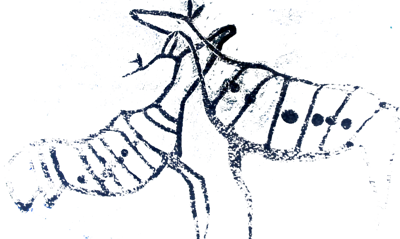
The town of
«Tepsey»
«Not in the sweet-and-sour subtopian summer camps but
on the inclement heights will you gain the speed of thought and initiative ».
N.K. Roerich
Our camp named Tepsey, which we called
jestingly «the town of Tepsey», became such an
"inclement height" for us. It is situated at the mouth of the river
Tuba inside the ring of the mountains Moiseiha, Sosniha and Suhaniha in the
pinery with a wonderful microclimate.
Where do gray herons nestle? Do you think
they do it anywhere on the swamp? No, they do it on the tops of the pines!
Their colony augmented from 2 - 3 couples to 50 - 60 ones in the time of
existence of our camp. And where do scoters live? In the same place, in this
beautiful oasis of Khakassko-Minusinsky basin. There you can hear a song of
oriole and watch fish-hawks hunt.
Our camp has lived in this favoured place
for 17 years. There we first saw the petrogliphs, which made us «awake» and give thought
to the necessity of preserving them. 
There are bare rocks engraved with
petrogliphs on the mountains, mentioned above. Those rocks are stone pages on
which the history of dead and gone times is written down. Representations of
various animals, signs, symbols and people are imprinted on those pages. They
are combined fancifully forming the endless stone book telling about the
outlook of those times, about the human and his place in the universe, about
religious rites of our forefathers and animals of those times.
Unfortunately in our album-catalog we can
only present some disjunct pages of these ancient messages to us, far daughter
nations of the tribes and folks that used to people this region of the Middle
Enisey. These messages do not have the exact addressee they are apostrophized
to every human. This is a huge strata of ancient culture, which is still poorly
learned and not read up to the end.
Petrogliphs like people do not live for
ever: they also get ill and die.The pictures are dimming and fading under the
rays of the Sun, the relief of the lines is being flattened and abraded by the
river current, ice and sand. Stone flats are friablings and crumbling.
The situation is even worse with the
petrogliphs that are situated in the zone of Krasnoyarsk generating-unit
headwaters. The water-level in the headwaters is continuously changing reaching
the differential of 15 -17
meters. This is an affliction for the petrogliphs, the
planes of which immerge intermittently and do not always emerge again
transmitting irreparably into chipping.
During the whole twentieth century the
petrogliphs were bemocked by modern savages who did not understand what they
were doing. Autographs by new-sprung chroniclers like «Vasya was here» were painted or
engraved with a stone over the petrogliphs.
How can we save the beauty of primigenial
art? How can we get through the import of obsolescent compositions? The only
acceptable way to do it is to save if not the petrogliphs themselves but their
copies at least. But what is the way to gain the most informative and close to
the original doublets of the petrogliphs? The answer to the question had been
sought by the scientists for centuries. And it was found.
V.F. Kapelko, painter from Abakan, and B.N. Pyatkin, archeologist from Kemerovo, designed,
approved and developed the method of contact-coping petrogliphs to vellum cloth
by way of printmaking. They are the authors of that original technique which is
remarkable for its simplicity and does not require spending much money. The
copies not only contain authentic scientific information but also they are the
great cultural values and perfect exhibits at museum expositions.
The pioneers of this method deceased but
their adherents have remained. Our collection contains more than 200 prints
copied from the petrogliphs of the rocks of the Middle Enisey. During the
school expeditions A.L. Zaika, archeologist and academic of Krasnoyarsk
state University, V.F. Kapelko's disciple, and B.A. Ampilogov, his co-worker,
teacher of History from the small town of Podgorny,
did printmaking. The students from the archeological camp Tepsey
were their never-failing assistants. The work with the masterpieces of ancient
art did not pass tracklessly for many of them. The impressions gained in
adolescence and youth will remain in their memory for long and will be conveyed
to their children and grandchildren.
E.S. Anninsky From the book: "Cave Art of the Middle Yenisey"
| 